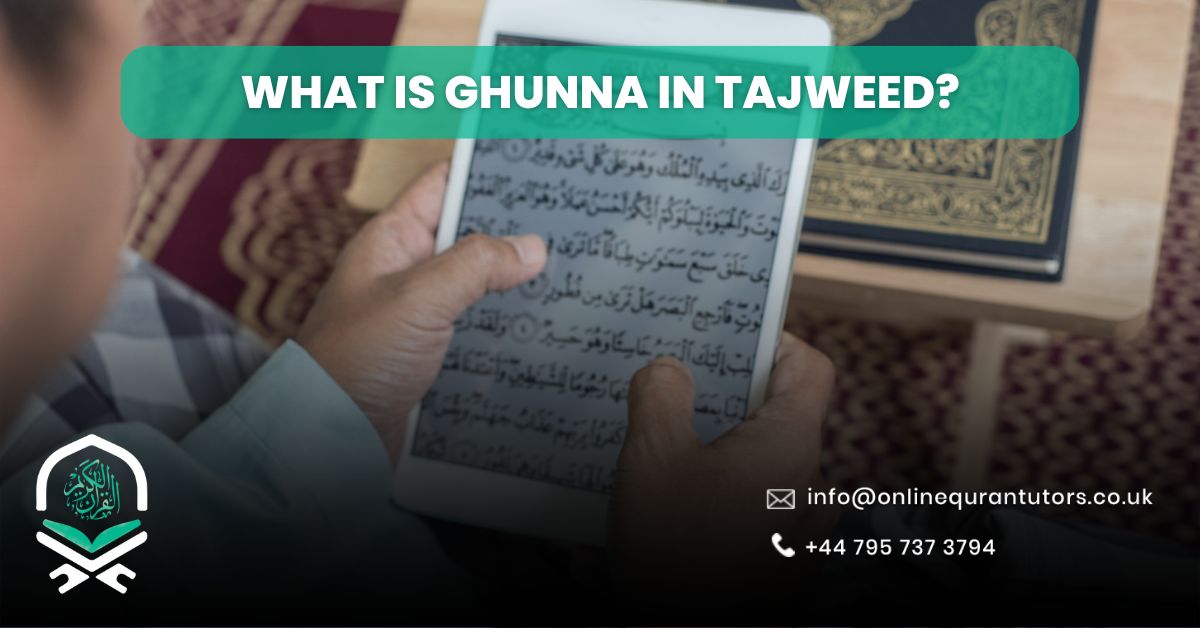Tajweed, which preserves the beauty, accuracy, and fluency of the verses revealed to Prophet Muhammad (PBUH), is a fundamental aspect of Quranic recitation. Among its many rules, Ghunna is one of the essential principles. In this blog, we will explain what Ghunna in Tajweed is, its different forms, the letters associated with it, and provide Quranic examples.
Ghunna is found in the letters “م” and “ن”. Whenever these two letters are pronounced, the sound passes through the nasal cavity, and this is called Ghunna. When either “م” or “ن” carries a shadda, the letter is recited with a clear ghunna lasting for two counts.
Understanding Ghunna in Tajweed
Learning to recite the Quran with correct pronunciation and rhythm is an act of love and respect for the words of Allah. One of the most beautiful and essential elements in Tajweed is Ghunna, the nasal sound that gives Quranic recitation its softness and harmony. Many learners find Ghunna fascinating because it brings depth and melody to the recitation.
To truly master it, learners often need guidance from experienced Quran tutors who can demonstrate the sound correctly and help them apply it naturally. At Online Quran Tutors, our teachers specialize in teaching this art gently and clearly, helping students develop a soulful connection with their recitation.
What is the literal meaning of Ghunna?
Ghunna is a nasal sound produced from the nose, not the mouth. It is a continuous humming sound that lasts for about two counts. In Tajweed, Ghunna is not a letter itself, but a characteristic that belongs to two letters, Meem and Noon. Whenever these two letters appear with certain signs or within specific rules, Ghunna becomes part of the pronunciation. It adds a flowing and rhythmic beauty to the recitation, ensuring that every sound blends smoothly.
The Importance of Ghunna in Tajweed
Ghunna is more than a sound; it is a reflection of discipline and devotion in reciting the Quran. The Prophet Muhammad (peace be upon him) emphasized reciting the Quran with Tajweed and precision. Ghunna ensures that letters are given their rightful sound and duration. When ignored, it changes the melody and can sometimes affect the meaning. Therefore, mastering Ghunna is essential for every reciter, whether beginner or advanced.
Skilled teachers can help students recognize where Ghunna naturally occurs, such as in rules like Idgham, Ikhfa, and Iqlab. At Online Quran Tutors, our instructors pay close attention to each student’s articulation, helping them refine every detail of Ghunna with patience and care so that their recitation becomes both accurate and spiritually uplifting.
Also Read: What is Izhar (Idhhar) in Tajweed?
How and When Ghunna is Used?
Ghunna appears in many places during recitation, but especially when Noon Saakin or Meem Saakin meets specific letters. For example, when Noon Saakin or Tanween is followed by the letters of Idgham with Ghunna (ي، ن، م، و), the sound of Ghunna must be applied. Similarly, in Ikhfa, Ghunna softens the blending of sounds when Noon Saakin comes before the fifteen Ikhfa letters. The same rule applies for Meem in Ikhfa Shafawi, where Meem Saakin meets Ba. Each situation has its unique sound, duration, and nasal tone.
Without proper guidance, it can be difficult to distinguish when to apply Ghunna correctly. Our expert tutors use repetition and listening techniques that allow learners to identify and produce Ghunna instinctively. They combine theory with practice, ensuring students not only understand the rule but also feel its beauty in their voice.
Ghunnah Rules:
Ghunnah is a nasal sound that lies between a hum and a soft moan. The following points are important for applying the rule of Ghunnah correctly:
Duration of Two Harakahs
The Ghunnah sound should be held for two harakahs (two counts). This timing ensures that the nasal tone is neither cut short nor drawn out too long. It helps preserve a smooth and steady flow in recitation, which is vital for proper Tajweed.
Producing the Nasal Sound Properly
Ghunnah must come from the nasal passage, creating a gentle and continuous tone. It should not sound rough or strained. Correct nasal resonance is essential to achieve the proper sound while following Tajweed rules.
Accurate Letter Merging
When Noon (ن) or Meem (م) is followed by letters that require idgham (merging), the Ghunnah must be applied during the merge. The nasal sound should flow naturally between the letters to maintain clarity in recitation.
Avoiding Exaggeration
Although Ghunnah is required, it should not be overstressed. Overdoing the nasal sound can disturb the balance of recitation and reduce its quality. Keeping it moderate ensures correct pronunciation without altering the intended meaning of the text.
Also Read: Qalqalah In Tajweed | Letters, Types, Rules & Examples
The Spiritual and Aesthetic Beauty of Ghunna
Ghunna brings emotional beauty to Quranic recitation. It makes the reciter’s voice soft, humble, and musical. When performed correctly, Ghunna adds harmony and reflection to the verses, helping listeners feel the depth of divine words. It is not just a technical feature, it is a spiritual art. Many famous islamic scholars of tajweed are known for their perfect use of Ghunna, which makes their recitation sound peaceful and captivating. Learning this sound helps a student connect not only to the Quranic rules but also to the emotional rhythm of the verses. Our Quran tutors understand this balance deeply. They guide students to recite with both accuracy and feeling, ensuring that every learner develops a heartfelt connection to their recitation through Ghunna.
Ghunna is a gift in the art of Tajweed, a sound that adds softness, flow, and depth to the recitation of the Quran. It teaches discipline in pronunciation and grace in delivery. Mastering it takes time, but with the right teacher, it becomes an inspiring and rewarding journey. At Online Quran Tutors, we believe that every learner can achieve excellence in Ghunna through proper guidance and practice. Our tutors are passionate, patient, and skilled in nurturing a love for Quranic recitation. Begin your journey toward mastering Ghunna today and let your recitation reflect the beauty and precision that the Quran deserves.
Join Online Quran Tutor UK – Start Your Free Trial Today!
Looking to improve your Quran recitation with proper Tajweed? At Online Quran Tutor UK, we offer expertly designed Quran with Tajweed Online Course for learners of all ages. Our qualified instructors make complex Tajweed rules simple and engaging through interactive lessons, practical examples, and easy-to-follow video sessions.
Whether you’re a beginner or looking to refine your recitation—we’re here to support your journey every step of the way.
📘 Courses We Offer:
- Noorani Qaida Course
Learn the basics of Arabic pronunciation and Quranic phonetics. - Online Tajweed Course for Kids
Tailored for young learners with fun, engaging lessons that build strong foundations. - Quran Reading Course
Strengthen your fluency and confidence in reading the Quran accurately and beautifully.
We also offer:
📞 Contact us today to book your free trial class and begin your Quranic journey with expert guidance and flexible learning options!
Conclusion
Ghunnah is a fundamental aspect for anyone wishing to recite the Quran with accuracy and elegance. The nasal sound involved in Ghunnah is not just a matter of pronunciation but also a spiritual act that connects the reciter to the authentic sound and meaning of the Quran as it was revealed.
Whether practiced in Ikhfaa, Idghaam, or Iqlab, understanding the rules of Ghunnah strengthens one’s bond with the sacred text and enriches the recitation experience. By studying and applying these principles, reciters both preserve the traditional style of Quranic recitation and fulfill their duty to recite the Quran correctly.





